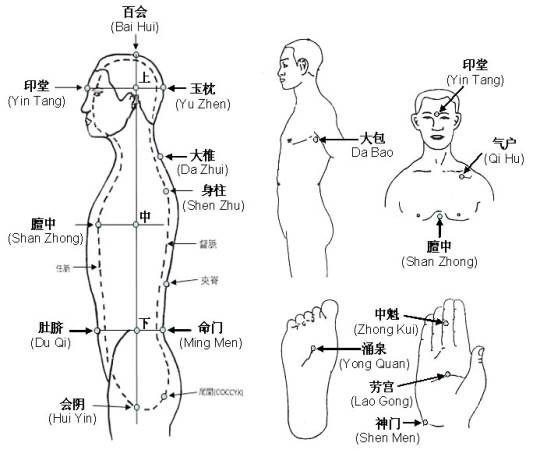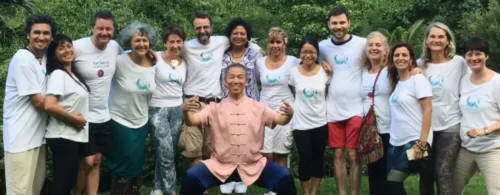ABOUT
Zhineng Qigong
Human Potential
transformation
In the practice of Zhineng Qigong, we learn to embody the rhythm of nature with its seasons and cycles through the movement and breath of our bodies, the love and compassion of our hearts, and the thoughts and intention of our minds. We learn that instead of having a knee-jerk reaction to a situation that presents itself, we can use the situation to become clearer about our intention to create the life we want. And that by aligning with our intention through the practice, we strengthen our will, accessing not only the possibility of healing but exploring the power of our human potential.
Zhineng Qigong is sometimes referred to as Zhineng Qigong science. It was created by Dr Pang Ming, a medical doctor (M.D), a doctor of Chinese medicine, and a Qigong Grandmaster. He studied Qigong under 19 different Grandmasters, and in 1979 he developed Zhineng Qigong as a result of his search for more powerful ways to help his patients heal. Zhi means wisdom; Neng means capability.
Zhineng Qigong explores what it means to be a human being and how our humanness communicates with all things in the Universe. The practice optimizes the exchange of Qi between the individual and the external world by using the consciousness to mobilize Qi.
The practice of Zhineng Qigong focuses on aligning the body, heart, and mind through the self-care practices of meditation, fluid movements, chanting/toning, self-massage, and developing focused intention. Every aspect of it – from meditation to chanting to movement – is organically connected to the rhythm of the universe in any one moment.
The Qi Field
When people participate in a Zhineng Qigong event, whether online or in person, they join a collective field that reflects the vibration of all those who have contributed to the field — students, teachers, masters. This is called the Qi Field. The mind is used as part of this practice to “create and enter” the Qi Field.
The Qi Field is how the universe expresses itself, and it mirrors the vibration of the intersection of the form and formless aspects of the human experience. It is the place where all healing takes place and the expansion of the human form reaches its full potential.
Online trainings offer something special. For many people, the freedom of solitude allows them to more fully embrace the vibration of the Qi Field without the distraction of feeling observed and the stress of interacting with others. This can deepen the ability to focus within.
In-person retreats and classes allow the participant to experience the Qi Field amplified by the immediate proximity of the teacher and other participants who are also experiencing the shifts in conscious awareness. And for those attending in-person retreats, the continuual 24-hour immersion adds tremendously to the experience.
Organizing the Qi Field with The Eight Verses
Using the Eight Verses to organize the Qi field is a foundation of Zhineng Qigong.
Organizing the Qi field is to consciously merge within yourself and merge with the external environment harmoniously. This creates the optimal exchange of life force allowing the practice to enhance physical health, emotional intelligence, and the consciousness of every person in the field.
Organizing the Qi field is done before every practice whether it’s an individual or group practice. In a group, the leader’s gongfu (ability to be fully present and focused) guides the group through words, movement, or the power of their own field. Every participant also exponentially adds to the group Qi field.
顶天立地 ding tian li di – Head touches sky; feet stand on earth.
形松意充 xing song yi chong – Body relaxes; mind expands.
外敬内静 wai jing nei jing – Outside is respectful; inside is quiet, tranquil.
心澄貌恭 xin cheng mao gong – The mind is clear, like a still body of water; appearance is humble.
一念不起 yi nian bu qi – No distracting thoughts.
神注太空 shen zhu tai kong – The mind opens to infinite awareness, infinite potential.
神意照体 shen yi zhao ti – Bring that infinite awareness deep into the body to illuminate every cell.
周身融融 zhou shen rong rong – The entire body is harmonized with Qi, harmonized with Qi
the basic points used in Qigong
- Bai Hui – (Hundred Meetings) Meeting point of the midline with the top of the ears
- Yintang – (Seal Hall) Between the eyebrows
- Shen Zhong – Midway between the nipples.
- Zhangmen – (Camphorwood Gate) lateral side of the abdomen below the free end of the 11th rib
- Du Qi – The navel; in the center of the belly button.
- Huiyin – (Yin Gate) in the middle of the perineum
- Ming Men – (Gate of Life) Below Lumbar 2, above Lumbar 3.
- Jingmen – (Capital Gate) at the end of the second floating rib
- Shen Zhu – (Body Pillar) on the midline below Thoracic 3
- Dabao – (Great Embracement) on the 6th ICS on the side of the chest
- Dazhui – (Big Vertebra) On the midline, below C7
- Yuzhen – (Jade Pillow) 1.3 cun* lateral to the midline, in the height of the occipital protuberance.
- Yintang – (The Impression Palace) Midway between the medial ends of the two eyebrows.
- Qi – Hu – (Qi Door) In the middle of the clavicle, the inferior margin
- Laogong – (Labor Palace) At the center of the palm between the 2nd and 3rd metacarpal bones closer to the radial side of the 3rd, where the tip of the middle finger falls when a loose fist is made.
- Shenmen – (Mind Door) Soothes and opens the orifices of the Mind (Shen). Nourishes the Heart Blood.
- Zhong Kui – (The Center Center) dorsal aspect of the middle finger, in the center of the transverse creases of the proximal interphalangeal joint
- Yongquan – (Bubbling Spring) On sole, in depression with foot in plantar flexion, at the junction of the anterior 1/3 and posterior 2/3 of line connecting base of the 2nd and 3rd toes with the heel.

*Cun is traditional Chinese measurement 1 cun is the width of a person’s thumb at the knuckle – this is how an acupuncturist measures where your points are on your body, based on your own individual measurement.)
*ICS – intercostal space


